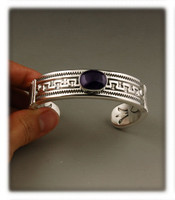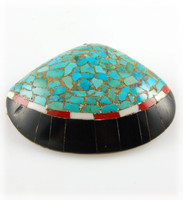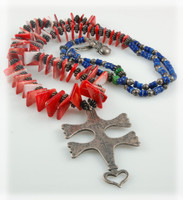 Loading... Please wait...
Loading... Please wait...- 970-759-1040 Text / Voice
- Gift Certificates
- My Account
Currency Displayed in
- Home
- Turquoise Learning Center
- Turquoise Information
- USGS History of Turquoise
Categories
USGS History of Turquoise
USGS History of Turquoise
USGS Turquoise History - Turquoise Facts
Turquoise, the robin's egg blue gemstone worn by Pharaohs and Aztec Kings, is probably one of the oldest gemstones known. Yet, only its prized blue color, a color so distinctive that its name is used to describe any color that resembles it, results in its being used as a gemstone. Turquoise has been, since about 200 B.C., extensively used by both southwestern U.S. Native Americans and by many of the Indian tribes in Mexico. The Native American Jewelry or "Indian style" jewelry with turquoise mounted in or with silver is relatively new. Some believe this style of Jewelry was unknown prior to about 1880, when a white trader persuaded a Navajo craftsman to make turquoise and silver jewelry using coin silver. Prior to this time, the Native Americans had made solid turquoise beads, carvings, and inlaid mosaics. Recently, turquoise has found wide acceptance among people of all walks of life and from many different ethnic groups.
The name turquoise may have come from the word Turquie, French for Turkey, because of the early belief that the mineral came from that country (the turquoise most likely came from Alimersai Mountain in Persia (now Iran) or the Sinai Peninsula in Egypt, two of the world's oldest known turquoise mining areas.) Another possibility could be the name came from the French description of the gemstone, "pierre turquin" meaning dark blue stone.
Chemically, a hydrated phosphate of copper and aluminum, turquoise is formed by the percolation of meteoric or groundwater through aluminous rock in the presence of copper. For this reason, it is often associated with copper deposits as a secondary mineral, most often in copper deposits in arid, semiarid, or desert environments.
For thousands of years the finest intense blue turquoise in the world was found in Persia, and the term "Persian Turquoise" became synonymous with the finest quality. This changed during the late 1800's and early 1900's when modern miners discovered or rediscovered significant deposits of high-quality turquoise in the western and southwestern United States. Material from many of these deposits was just as fine as the finest "Persian." Today, the term "Persian Turquoise" is more often a definition of quality than a statement of origin, and the majority of the world's finest-quality turquoise comes from the United States, the largest producer of turquoise.
The increased acceptance of turquoise resulted in higher prices, some of the most desirable materials going for as much as $2,200 per kg. The increased demand could not be met through production of acceptable mine run materials. Therefore, an industry emerged--the business of turquoise stabilization, reconstitution, and the manufacture of synthetic and simulated turquoise. In most instances, the stabilization and reconstitution of turquoise involve the use of earthy or highly porous types of turquoise which are pressure-impregnated with hot acrylic resins. The resins improve the color, hardness, and durability of the material to a point that inexpensive porous, poorly colored, or nearly colorless materials become suitable for use in jewelry. As long as the materials are represented as treated, stabilized, or reconstituted, the marketplace can accept or reject the materials based on decisions that are purely business or economic.
Arizona.--In Arizona turquoise ranks first in terms of value of production and is also the best known of its gem materials. As stated earlier, nearly all important deposits of turquoise are located near copper occurrences or in copper deposits in arid desert regions of the world. Thus, the world famous turquoise deposits associated with certain of the large Arizona copper deposits are to be expected. Turquoise is or has been mined from a number of these copper mines as a byproduct, usually by outside contractors.
The financial and operating terms of the collecting contracts vary from mine to mine. Some of the operations are little more than the efforts of individual commercial collectors. Some are essentially full-scale mining operations that are simultaneous with, but separate from, the regular mining operations; and still others operate on an on-call basis as turquoise is uncovered by the regular copper mining operation. Regardless of the size or the sophistication of the initial mining or recovery operation, the actual turquoise is recovered by careful extraction using hand methods.
California.--The production of turquoise from deposits in California can be traced back to pre-Colombian Native Americans. Prehistoric mining tools have been found in some of the old workings of the turquoise mines in San Bernardino County.
Over the years, the State's deposits have produced a substantial amount of turquoise. Deposits are located in San Bernardino, Imperial, and Inyo Counties. The material occurs as nodules and as vein filling. Most of the nodules are small in size, about the size of the end of your thumb, and the vein material is about 4 millimeters thick. In the better grade materials, the color varies from a pale to a dark blue, poorer grade materials are greenish-blue and green in color. Some of the material has yellow-brown limonite spider webbing.
In the past, a number of turquoise mines operated in the State, several or more mines in each of the counties. Today, only a single mine, the Apache Canyon Mine, is commercially producing turquoise. Material from the mine is a fine blue color, hard, and takes a good polish.
Colorado.--Turquoise is produced from several locations in Colorado. Currently the only commercial production is near Manassa, Conejos County. Other production was from Leadville, Lake County; near Colorado Springs, El Paso County; and near Villa Grove, Saguache County.
New Mexico.--Until the 1920's, New Mexico was the United States largest producer of turquoise. However, since then Arizona and Nevada has surpassed it in terms of both annual and total production.
Production of turquoise from deposits in the Cerrillos Hills, Santa Fe County; the Burro Mountains and Little Hachita Mountains, Grant County; the Jarilla Hills, Otero County; and the Guadelupe Mountains, Eddy County; can be traced to prehistoric Indians. Several different mines operate or have operated at each of the New Mexico locations mentioned, producing seam and nugget turquoise. Many of the more famous and higher-quality deposits are economically depleted. Turquoise from these deposits was as good as that from any deposit in the world and were the first to displace true Persian turquoise in the U.S. market. Color varied from light to dark green, greenish-blue, bluish-green, paler blue shades, and fine sky-blue. Much of the material was spider webbed with thin veinlets of limonite.
Currently, with the exception of byproduct material from copper mines, production of turquoise from deposits in New Mexico, for all practical purposes, has stopped. Turquoise still can be found in New Mexico, but production in any significant quantity is a question of economics and the determination of the individuals involved.
Nevada.--Nevada has been a major producer of turquoise since the 1930's, and until the early 1980's, the State was the largest producer in the United States. It is estimated that over the years, 75 to 100 different mines/prospects produced sizable quantities of turquoise. Production varied from a few thousand dollars worth of material at some of the properties to more than a million dollars at others. To date, total production of rough turquoise is estimated to be in the range of $40 to $50 million.
Turquoise from Nevada comes in various shades of blue, blue-green, green-blue, and green. Some of the turquoise may contain iron, if it does, its color is pale green to yellow-green to yellow. The material can be solid colored or spider webbed with either brown or black webbing; the spider webbing may occur in any of the different colors or shades. Some of the blue material is represented as the finest pure-blue turquoise produced. It can occur in thin veins or seams or as nodules, with single nodules reported as large as 150 pounds. The quality varies from hard solid material that takes a good polish, to soft porous material that can only be use as feed stock for treatment, enhancement, or stabilization processes.
Associated with some of the turquoise deposits are two other gem materials that can resemble certain colors and shades of turquoise, but are separate mineral species. The first is variscite, and the other is faustite. Both have been mistaken for and marketed as turquoise. Attractive gem stones can be cut from both variscite and faustite and therefore, would be note worthy as gem materials on their own.
We are always looking for great Turquoise and rare turquoise examples from all over the world. Please contact us if you know were to come across any, right now we are looking for Turquoise from California, Montana, Utah, and Virginia. We also collect rare gemstones. We are looking for great, magnetic lodestone. durangodillon@gmail.com












